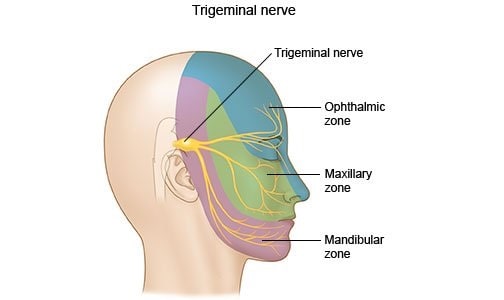Trigeminal Neuralgia, also known as Tic Douloureaux, is a chronic condition. In this medical condition, the patient experiences intense, sudden facial pain in a particular part of his face, resulting in the disruption of normal and routine activities. Taking medications can help treat these frequent, short episodes of pain, while the surgical procedure only stops the symptoms for a set period of time.
Trigeminal neuralgia can be diagnosed based on the pain you have, the triggers that trigger the pain, and the part of the face that hurts. However, people with the TN condition experience less intense pain from stimulating the cheeks, such as speaking, chewing, or even brushing their teeth. Along with neurological examination, it can discern the real cause of the pain. Even an MRI scan is also advised to get the exact information about the problem.
The cost of trigeminal neuralgia surgery depends on where you live and the doctor you are treating. However, the cost of treatment in India for surgical procedures ranges between Rs 50,000 to Rs 1 50,000.

The primary process for treating trigeminal neuralgia is to start taking medication as your healthcare provider recommends. In some cases, no further treatment is needed, while some may stop responding to drugs and experience unlikeable side effects. In this case, injections and surgery are other treatment options.
Surgery Options:
Surgical options for Trigeminal Neuralgia include multiple surgical procedures, which include the following:
This procedure involves the delivery of radiation doses directly to the root of the targeted trigeminal nerve. This method uses radiation to reduce/eliminate pain and damage to the trigeminal nerve. Like all surgical procedures although, there is a risk of reappearance, usually within three to five years. If it happens the same, the process can be repeated.
This method of treatment involves removing or relocating the blood vessels that are in contact with the trigeminal root to prevent nerve damage. A healthcare provider makes an incision behind the ear on the painful side in the middle of the procedure. Through a small hole in the skull, your doctor moves any arteries that are in contact with the trigeminal nerve away from the nerve.
This surgical procedure can help reduce or eliminate pain for several years, but it can reappear after 10 years. Even though this method has been around for a long time, it has various risks, including facial weakness, hearing loss, stroke, numbness, and other threats.
In this method, a hollow needle is inserted through the patient's face and guided to the part of the trigeminal nerve that runs through the base of the skull. Your healthcare provider inflates the balloon with enough pressure to block pain signals and damage the trigeminal nerve. In most cases, balloon compression successfully controls the pain for some time.
Inserting a needle through the face is involved in this process and often relieves pain. Some people may experience tingling or facial numbness in this method.
In this method, nerve fibers are destroyed, which causes pain. Your surgeon inserts an electrode with the help of needle and sends a mild electric current through the tip of the electrode. Radiofrequency usually works to result in some temporary facial numbness.
Q1. What are the side effects after trigeminal neuralgia surgery?
Ans: The patient will experience minimal but certain side effects after trigeminal neuralgia surgery. These side effects include nausea, dizziness, confusion, and drowsiness. People taking microvascular decompression may experience facial numbness, stroke, facial weakness, and loss of hearing. The side effects associated with brain stereotactic surgery include numbness in the face. Surgery has several side effects, such as swelling, bruising, and aches.
Q2. Is trigeminal neuralgia serious?
Ans: Trigeminal Neuralgia is attended by serve pain frequently, which is one-sided in nature. It is like a sharp radiating pain that goes through the face and feels resembling an electric shock. Due to the severity of the pain, one may be unable to drink or eat. And it can last for minutes or longer. It can be caused by drinking, eating, brushing teeth, or touching something on the face.
Q3. Is Trigeminal Neuralgia treatment and surgery permanent?
Ans: No, the treatment or surgery for this condition may not last long. This may happen after years or in a shorter period of time. However, treatment and dosage are focused on relieving and eliminating pain.
Q4. What food should be avoided in Trigeminal Neuralgia
Ans: If you may experience triggers of trigeminal neuralgia, you should not consume spicy and hot food and drinks and cold beverages. In addition, you should consume liquid meals instead of solid food. You also need to add citrus fruits, caffeine, and banana to your diet.